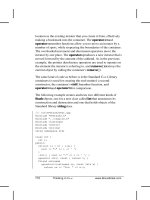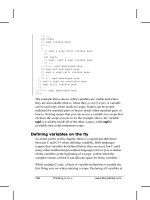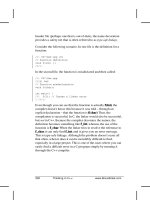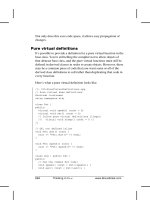IT training epic failures in devsecops, volume 1 khotailieu
Bạn đang xem bản rút gọn của tài liệu. Xem và tải ngay bản đầy đủ của tài liệu tại đây (7.3 MB, 180 trang )
The best businesses rely on Sonatype to automate
open source governance early, everywhere,
and at scale in support of their DevSecOps practices.
Release Faster
Nexus Lifecycle
Nexus Firewall
Develop
Build
Package
Test
Deploy
Operate
Nexus Auditor
Control Risk
Nexus Repository
Nexus
Intelligence
Nexus Lifecycle
Nexus Firewall
Empower teams and infuse
every phase of your pipeline
with precise component
intelligence
Vet parts early and stops
defective components from
entering your DevOps supply
chain
Nexus Auditor
Nexus Repository
Examine the quality of open
source components within
production applications
Organize and store parts in a
universal repository and share
them across the DevOps pipeline
Nexus Intelligence
Precise & polyglot intelligence,
curated by world class experts,
fuels the Nexus platform
Learn more at www.sonatype.com
Epic Failures in
DevSecOps
Volume 1
Copyright © 2018-2019 DevSecOps Days Press
All rights reserved. No part of this publication may be reproduced,
distributed, or transmitted in any form or by any means, including
photocopying, recording or other electronic or mechanical methods, without the prior written permission of the publisher, except in
the case of brief quotations embodied in critical reviews and certain
other noncommercial uses permitted by copyright law. For permission requests, email the publisher at
ISBN: 9781728806990
Imprint: DevSecOps Days Press
Publisher:
DevSecOps Days Press
48 Wall Street, 5th Floor
New York, NY 10005
www.devsecopsdays.com
Epic Failures in
DevSecOps
Volume 1
Aubrey Stearn
Caroline Wong
Chetan Conikee
Chris Roberts
DJ Schleen
Edwin Kwan
Fabian Lim
Stefan Streichsbier
Mark Miller, Editor
“The stories presented here are not a roadmap. What they do is
acknowledge failure as a part of the knowledge base of the DevSecOps
Community.” — Mark Miller, October 2018
Table of Content
Introduction ............................................................................ ix
Chapter 1: We Are ALL Special Snowflakes .................................. 1
Chapter 2: The Security Person Who Is Not Invited
Into the Room .......................................................... 31
Chapter 3: The Problem with Success ......................................... 43
Chapter 4: The Table of the Burning Programme ....................... 61
Chapter 5: Threat Modelling – A Disaster .................................. 85
Chapter 6: Red Team the Culture ............................................. 111
Chapter 7: Unicorn Rodeo ....................................................... 127
Chapter 8: Strategic Asymmetry – Leveling the Playing Field
between Defenders and Adversaries ......................... 143
Conclusion ............................................................................ 159
Acknowledgments .................................................................. 163
Introduction
October 2018
W
e learn more from failures than we do from successes.
When something goes as expected, we use that process
as a mental template for future projects. Success actually stunts the learning process because we think we have established
a successful pattern, even after just one instance of success. It is a
flawed confirmation that “This is the correct way to do it”, which has
a tendency to morph into “This is the only way to do it.”
Real learning comes through crisis.
If something goes wrong, horribly wrong, we have to scramble,
experiment, hack, scream and taze our way through the process. Our
minds flail for new ideas, are more willing to experiment, are more
open to external input when we’re in crisis mode.
The Genesis of an Idea
That’s where the idea for this book came from. When I was in Singapore for DevSecOps Days 2018, Edwin Kwan, Stefan Streichsbier
and DJ Schleen were swapping war stories over a couple of beers.
The conclusion of their evening of telling tales was the desire to find
a way to get those stories out to the community. They spoke with me
about putting together a team of authors who would tell their own
stories in the hope of helping the DevSecOps Community understand that failure is an option.
x Epic Failures in DevSecOps
Yes. You read that right. Failure is an option.
Failure is part of the process of making the cultural and technological
transformation that needs to happen in order to keep innovating.
It is part of the journey to DevSecOps. The stories presented here
aren’t a roadmap. What they do is acknowledge failure as a part of
the knowledge base of the DevSecOps Community.
What to Expect from this Book
This is the first in a series of books tracking changes and discoveries
within the DevSecOps Community. The stories are by people who
have been sloshing around in the swamps of software development
for years, figuring out how things work, and most importantly, why
things didn’t work.
Chris Roberts starts us off with how the industry as a whole has
failed us when it comes to software security. DJ Schleen, Edwin
Kwan, Aubrey Stearn, Fabian Lim and Stefan Streichsbier provide
a practitioner’s view of being up to their waists in the muck of an
epic failure. Caroline Wong and Chetan Conikee bring another view,
peering into the murky waters of DevSecOps from a management
perspective.
Each chapter follows a specific format:
•
•
•
•
•
Overview, what were you trying to accomplish
What went wrong, how bad was it
How did the team try to resolve the issue
What was the final outcome
What were the lessons learned
Following this type of format, we should be able to create a series of
stories, surfacing patterns we as a community can use to safely push
the boundaries of software development.
Introduction xi
Invitation to Tell Your Story
The days of stand-alone security teams isolated from the real process
of development are coming to an end. Paraphrasing Caroline Wong,
“Security needs to be invited to the party, not perceived as a goon
standing at the front door denying admission”. With DevSecOps,
security is now part of the team.
After reading these stories, we hope you will realize you are not alone
in your journey. Not only are you not alone, there are early adopters
who have gone before you, not exactly “hacking a trail through the
swamp”, but at least marking the booby traps, putting flags next to
the quick-sand pits and holding up a ‘Dragons be here’ sign at perilous cave openings.
On DevSecOpsDays.com, we’ll be expanding the ideas and concepts
talked about in this book. We look forward to your participation in
the community, whether as organizers of regional DevSecOps Days
events, as article contributors to DevSecOpsDays.com or as an author
of your own Epic Failure on your journey through DevSecOps.
What would your warning sign say? We ask you to join our journey
as we continue to learn from your Epic Failures.
Mark Miller
Founder and Editor in Chief, DevSecOpsDays.com
Co-Founder, All Day DevOps
Senior Storyteller, Sonatype
xii Epic Failures in DevSecOps
Chapter 1
We Are ALL Special
Snowflakes
by Chris Roberts
2 Epic Failures in DevSecOps
Chapter 1 – We Are All Special Snowflakes 3
Chapter 1
We Are ALL Special Snowflakes
T
wenty-five years ago we, the network team and the various
information security teams (in their infancy) walked into
their CEOs’ and CFOs’ offices and proudly stated, “We need
a firewall to protect us!” We started a chain of events that have led us
to today’s rather messy situation. For those 25 years or more we have
continued to walk into the leadership’s corner office and state that
the next greatest thing will fix all the problems, secure all the things.
We’ve done it by stating that the general reason we have to do this is
because it’s the users’ fault, or the developers’ fault, or the engineers’
fault. Heck at one point I think I even blamed my grandmother for
breaking security on the Internet.
For many years, we have continued to look at others as being culpable. We were special; we were the new warriors; the fighters of all
things bad in the world; and, we were the only ones protecting the
company against the perils of the modern era. Recently however, a
growing number of folks have joined their voices together in earnest
and started to rebel against the industry. Questions over tactics, over
media portrayals and over the spread of fear, uncertainty and doubt
throughout industry, in an effort to further the realm of security,
are now being met with voices from within. Quite simply the tide
is turning and our own industry is starting to introspectively look at
what it’s become and how it has to change to actually protect the very
charges (companies and individuals) it has forgotten about, and to
address all that is wrong within InfoSec/Cyber.
Fundamentally, we have realized how wrong we were and, unfortunately, how very wrong we still are. And, how much we have to learn
and, more importantly, how quickly we have to learn it.
*Snowflake: an individual with an inflated sense of uniqueness, or an
unwarranted sense of entitlement. (Wikipedia….)
4 Epic Failures in DevSecOps
A Closer Look At That History:
The primordial ooze of technology
Around 500 BCE, the abacus came into existence…and remained
the definitive form of calculation until the middle of the 17th century. Think about that, over 2000 years with the same piece of technology in use, working effectively and not a single call center, vendor
support network or venture capitalist in place to mess with it. The
abacus saw us through some amazing changes in the world around
us and, eventually, it was replaced by Blaise Pascal’s mechanical calculator. The Frenchman’s invention lasted 30 years until a German,
Gottfried Wilhelm Leibniz, improved drastically upon the technology and gave us our first glimpse of what we know now as memory.
Those of you who are paying attention during this quick history lesson will recognize our intrepid German mathematician/philosopher
as the very same individual who presented the world with Binary.
One hundred years later (give or take a few) an Englishman, George
Boole, took the whole concept of binary, threw it at a chalkboard and
walked away a while later with an entire branch of mathematics that
(thankfully) survives to this very day in the world we now have to
untangle…Boolean algebra. The combination of binary and Boolean
allows our modern systems to make sense, and simple decisions by
comparing strings of ones and zeros.
So, at this point we have calculators, rather fantastic ones, yet still
devices that require human input, and human hands at each stage.
So, we’ve not (by definition) reached the age of computing which is
where a machine is able to operate a program, or series of instructions, autonomously without the aid of a human. For this we have
to look at the “father of computing” (no, not Al Gore) but Charles
Babbage, and arguably the first “mother of computing” or computer
programmer Englishwoman Augusta Ada King, the Countess of
Lovelace (or Ada Lovelace). Between Babbage’s innovative ways of
looking at inputs, memory, processing, and outputs, and Lovelace’s
algorithms (Notes), as well as her forward thinking concepts about
Chapter 1 – We Are All Special Snowflakes 5
how these systems could evolve past simply number crunching, we
see the start of the age of computers.
Now, we both fast forward to the 1880 and take a leaf out of the 1700s
and combine the art of punched card with the technology of the era--the
tabulator. Herman Hollerith, a statistician managed to take the census
from a 7.5 year task to one of tallying it in six weeks, and full scale analysis in 2.5 years. The Tabulating Machine Corporation was set up (1896)
which then changed names to the Computing Tabulating Recorder, and
then to one that’s familiar to us ALL in this industry, IBM.
The early days when we learned to talk to the
technology
At this point, we had the machines, we’d worked out how to use them
for some basic functionality, but we knew they could do more. Next, we
had to work out how. For that we turn to another amazing figure in our
history, Alan Turing, whom we can thank for the groundbreaking work
on the theories of how computers process information. Turing is also
known for several other key moments in our early history, that of the
code-breaking machinery, the Enigma, and of the Turing test which is a
method to see if a computer can be considered intelligent by measuring
its ability to sustain a plausible conversation with a real human.
The time of Women (and why didn’t we keep it
that way for heaven’s sakes!)
As we’ve already discussed, Ada Lovelace was the first programmer.
Following her, we had the Pickering Harem, the rather ungracious
name given to the female team that worked at the Harvard Observatory with Pickering processing astronomical data sets. The logic at
the time was that work was considered clerical and the women could
be hired at a fraction of the cost of a comparable male (incredibly,
this battle is still being fought over 140 year later.)
The concept of the “human computer” harks back to these days and
is often used as a reference as we move through history (NACA’s computer pool being the 1930/40’s version). Then we move to the 1940s
6 Epic Failures in DevSecOps
and arguably the Grandmother of COBOL, Grace Hopper. She was
the first person to develop and create a compiler. The simple logic being
her belief that a programming language base on English was possible
and that converting English to machine code, to be understood and
executed by computers should be possible… Her achievements and her
foundations led to the Mk1, the UNIVAC and host of other systems
that have pioneered some of these countries greatest moments. While
talking about the early days, it is well worth remembering the pioneering mathematicians, and their teachers and trainers who worked on the
ENIAC computer: Adele Goldstine, Marlyn Meltzer, Betty Holberton,
Kathleen Antonelli, Ruth Teitelbaum, Jean Bartik, and Frances Spence.
Fast-forward to the late 50s and early 60s and we run smack into
the real-life history behind the movie, Hidden Figures. Dorothy
Vaughan, Mary Jackson and Katherine Johnson among others who
were literally the brains behind the NACA (later NASA) work at that
time and went head-to-head with the likes of the IBM 7090s.
It’s a man’s world
Then we hit the 80s and computer science became “cool.” (Let’s face
it, we were still nerds and geeks.) The computing focus started to
shift towards it being a male profession. In part, we have to blame
the advertisers, the game manufacturers, and the early PC developers--all of them targeted the male, the boys, and the companies that
for the most part were run by “male geniuses”. Within the college
arena, computer science ended up in its own space, separated from
the other sciences, humanities and other integrated areas, thereby
reinforcing that separation from the rest of the baseline subjects that
would typically attract a much more diverse crowd.
So, we have games for boys, computers being sold to the teenage boy,
and advertising and college promotion aimed at the boys, and the
whole field was having a massive influx of students, most of whom
grew up with computers, who thought computing would make a
good future. Not an ideal situation for fostering a diverse set of ideals, especially when there was a movement among some folks to treat
knowledge as privilege or power, and should not be readily shared or
used for the good of many.
Chapter 1 – We Are All Special Snowflakes 7
The mainframe, we should never have let it out
of the room
We had it all nicely under control, a room, a green screen and a
person guarding the door--sometimes with a gun. You either got in,
or got shot--simple binary response. The problem was the PC revolution was going nuts. Intel, Wozniak, Jobs, Kildall and Gates were
all focused on bringing the computer to every home, every office and
eventually moving the data from that monolith in the room to the
desktop. For a while they co-existed, (remember the 3270 emulators and all the fun setting those up?) but eventually the PC market
spawned the file server, the database server, and from that moment
on the spread of data exploded.
We were doing so well and then--and this is the only time I’ll say
this--Apple ruined it all.
The distribution, time for tokens, and green
screens
Token ring, MAU’s CAU’s (Mows and Cows) 4, 16, then this
thing called Ethernet. In the middle was Banyan Vines and a host
of other things. This was the time of “cable and re-cable”-- and
do it all again with fiber-- oh, and now--Ethernet! The continual
cracking open of the user’s computer case for a new card, followed
by a floppy drive install of drivers and you’d better hope you had
the right settings otherwise the whole bloody thing fell around
your ears.
Between changing out cards, computers, math coprocessors and
installing WYSIWYG on the early spreadsheets, these were the days
when we touted our knowledge, our experience and our absolute
thirst to work out what was going on, how it all worked, and what
we had to plan for next.
This was when we, the IT folks, should have been working much
closer with businesses to understand and help them work out how
they could and would use the technology. We didn’t do a good
enough job to see how the transition from the mainframe to the
8 Epic Failures in DevSecOps
client server world would affect companies; we spent too long chasing the latest technology and not enough time listening to the very
businesses we were beholden to.
The emergence of the giants, and the time we
ALL wish we’d bought stock
This is the time we should have taken things seriously, taken a long
look at the future and realized this was the time we had to make the
necessary changes. We should have seen the shift in momentum and
the emergence of the small companies with money behind them that
took on and won against the giants.
We all kick ourselves for not buying Microsoft stock, or any of the
other giants, that emerged in this era.
From BBS to Internet, the shift in momentum
from hoarding data to seeing it everywhere
How many of us remember building, maintaining and using the
banks of modems in various closets all across the planet? The boards,
the early days of being able to share information that’s turned into
all the data everywhere. How many of us, back then, would have had
the vision: that what we had, would eventually turn into what we
now see all around us?
The proliferation of information is both fascinating and daunting. At least back in the early days you could, if you needed to,
simply pull the plug on the board and a large chunk of things
would go off line. These days that concept of being able to turn
it all off has long since disappeared. We talk about being able to
reset it should the worst happen, but at this point technology
is so integrated into almost every part of our life that the negative consequences arguably outweigh any benefit. There’s logic
to that being part of the reason we simply accept the inevitable
when it comes to the Internet and that identity theft, crime, and
the complete lack of privacy is simply the price of pay to play.
Chapter 1 – We Are All Special Snowflakes 9
I do not agree, I cannot agree and refuse to accept the current
thinking. Quite simply, this indifference is something that has
to change.
Apple’s back and what the hell did they do
with the “phone”
11 years ago, the iPhone was released and it quite simply changed the
landscape, tore up the smartphone book and really kicked the mobile
revolution into high gear. How revolutionary and how much did we
mess up when it comes to being able to help this revolution be a safer
and secure one? Let’s explore:
First, the iPhone was an Internet device. It was a phone, yes, but
when you look at the growth of data vs. voice traffic in the last 11
years, it quite simply moved the Internet from the desktop/laptop
right into our hands all the time.
Second, we all became both consumers and proliferators of information. Back in 2011 it was estimated 400 billion digital photos were
taken, fast forward to 2017 and the statistics are sitting at 1.2 trillion
photos. We are simply moving everything we see, do and interact
with into these devices that are sitting in our hands. Unprotected.
Third, we changed how we purchase software, applications and services. We use to spend time pondering the difference between all the
separate software neatly stacked on the shelves. We pored through
the PC magazine reviews, talked to the vendors and basically did
enough due diligence to assume we’d made the best choice possible.
Now we look at our $11 billion app-store shopping habits. Between
the two main app stores out there, there are 6 million apps to choose
from. Our diligence these days is limited to which one looks good,
and answers these questions: Is it free? Does it offer in-app purchases?
Can we get rid of the adverts? And will it integrate with whatever
password manager we’re using on the phone? We sometimes check
reviews; however, we rarely care about whose hands are on the keyboard or what other data, access or “integration” they need to have
with our device. Privacy and safety has taken a back seat to convenience and we, the IT/InfoSec/DevSecOps folks, have done little to
10 Epic Failures in DevSecOps
help consumers understand the risks, nor helped mitigate those risks,
until it’s too late.
There are heaps more examples of how the iPhone has reshaped the
world around us, and how we have adapted (not always in a positive
manner) to its introduction into our lives. We have the computing
power of a mainframe in our pockets, with the ability to change our
lives in so many positive ways, yet we continue to fail to understand
how best to use that. The introduction of the iPhone and its subsequent impact on the safety and security of how we interact with
technology really drives home Lord Acton’s advice in the mid-1800s
that “absolute power corrupts absolutely”.
All your technology, all the time, everywhere,
with everyone
Somewhere in the middle of the mobile revolution, we arguably
lost the battle. We were already fighting Bring Your Own Device
(BYOD) and as IT and InfoSec, we threw up our hands, declared all
mobile technology banished from our realms. And, we were summarily ignored by the users, businesses and the world in general. The
mobile revolution moved the IT/InfoSec/DevSecOps teams from
being the drivers into being the also-rans. Now, we had to adapt
faster than we’d ever had to in prior years. We had to help a business
understand how this technology would be used, and at the same
time, deal with the implications of securing what was rapidly becoming a vanishing perimeter. There’s an argument that when the laptop
arrived we lost any vestiges of a perimeter, but for most of us who
remember those early heavyweights they were about as “portable” as
a desktop and as useful as a boat anchor. Because of those reasons,
we still had some elements of perimeter because folks simply didn’t
want to have to deal with them. When the iPhone and subsequent
smartphones arrived any perimeter quickly vanished.
Chapter 1 – We Are All Special Snowflakes 11
Where Are We Today?
Let’s take a quick, high-level look and break it
down piece by piece
In 2017, across the whole information security industry we spent the
best part of $90 billion; some of that was for the ongoing/running
of existing systems; some of that was technical debt; and a chunk of
it was for things that folks saw at conferences and were persuaded
they needed to buy and integrate into their environments. At the
same time we, as an industry, the protectors of our charges, managed
to lose “somewhere” between 2 and 8 billion records--that’s social
security numbers, healthcare records, privacy information, banking/
financial data and anything else that can be used against people to
extort them.
So, how come we’ve managed to spend so much money and have
so little to show for it? Why are we still looking around for the
easy button and why the heck are we on track to spend even more
in the next few years. All this as the criminal statistics are even
more staggering. There’s a consensus that our industry will provide continual fertile ground for criminal activities to the global
tune of $6 trillion in anticipated damages in 2021, up from $3
trillion a few years ago.
Let’s break it down into some quick manageable chunks and see what
we can make of it:
Our Fragmentation
Our industry has fragmented, not just in the early days of IT when
we split into networking, database, desktop, server and a small gathering of other areas (developers, etc.), but when information security
overlaid itself onto each of the IT roles and exploded from there.
We’ve been adding new and interesting titles each time a technology
or buzzword is released. Today, we have hundreds of roles just within
security.
12 Epic Failures in DevSecOps
Then, we overlaid the word “cyber” onto everything and that just
confused everyone.
Then we formed chapters for ISSA, ISACA, ISC2, OWASP and host
of other things.
And then we decided to have conferences, and those conferences
spawned other conferences, which spawned “annoy the conference” conferences. Now we have a new one every week--which is
good because it spreads the word—but bad because the word itself
is too spread, out and diluted to the point of noise at times. And
nobody really knows who to listen to, why to listen to them, or
what logic to use to understand the value of what they are saying.
So, we’ve taken a core group, fragmented it, expanded it, but have
failed to retain any strong bonds between each of the fragments or
any of the expansion kits.
Led by money not protection
“I’ve got an idea!” Both the greatest words to hear and the most frightening to those of us who have scars from being in the industry a
while. Let me explain.
Your idea might be the next greatest, and safest mousetrap, but you
have to develop it, market it, support it and critically tell everyone
that it is the next best mousetrap. All this takes time--and critically
money. So you borrow some money, friends, family and the kids
down the street all chip in. You are beholden to them, so you don’t
sleep and you get the prototype out. Folks like it but you need to
get to the market first, you need market share, you need to convince
people that this is the mousetrap they need.
So, you borrow more money--this time from an institution and this
time they want to make sure you are doing it right (their way, or
with their help)--so they take some of your company and they help.
Sometimes this is good, and sometimes this is a challenge, dependent upon who’s doing the leading and who’s doing the following.
Meanwhile you need to still build the Mark 2 version and market
Chapter 1 – We Are All Special Snowflakes 13
it, and make it safe and secure, and you need to do it yesterday!
And you still need to do the 101 other things necessary to run a
business.
So, you go round in circles, possibly borrowing some more
money from more people who want to help, and now you are
beholden; you must make sure that those who have invested in
you and your mousetrap get a good return. You put time and
effort into making sure it’s marketed, it’s sold and it’s “out there”
and less time on the real reason for starting the whole process in
the first place. The mousetrap has become simply a vehicle for
making money, and not for protecting the very charges you set
out to look after.
The illusion of red teams
“I want to be a penetration tester!” Congratulations! Join the queue
and line up to break one of the 20-25 billion devices that will be
in service by 2020/2021. How about we stop breaking things and
spend more time fixing them? We’re really good at coming in, breaking it and then wandering off all happy, full of ourselves that we’ve
once again shown the developers, network types, systems folks or
users that we can continue to break whatever’s put in front of us.
We’ll even give you a nifty report (hopefully something more than a
rebranded Nessus PDF.)
So, what’s the solution? How about this approach: “I would like to
work on defending and ensuring the integrity, safety and security of
systems.” This is far more collaborative with the entire organization,
much more valuable--and given where technology is heading, and
may result in much better long-term prospects.
Red is necessary. We need to be able to think as the attackers, to be
able to maintain the security within the organization by continually
testing the controls and technologies and the humans that protect
it, but that team has to work in conjunction with the blue team, the
internal defensive teams. Collaborative testing that engages on all
levels has to be considered for the future.









